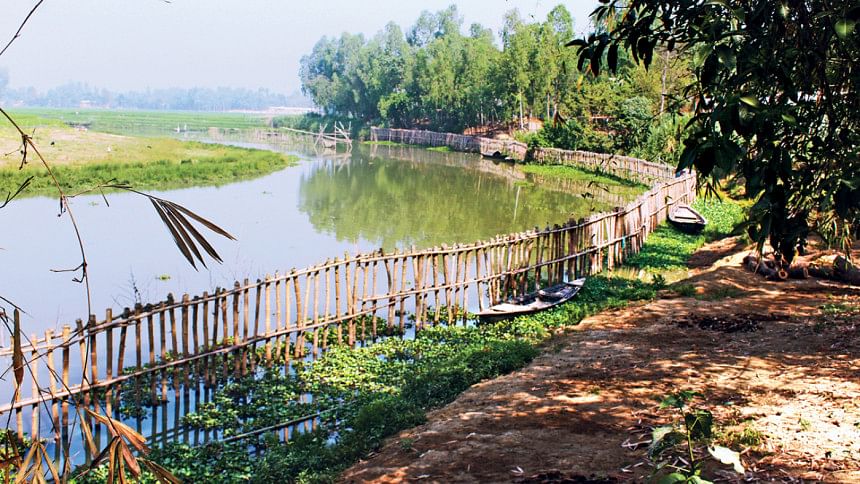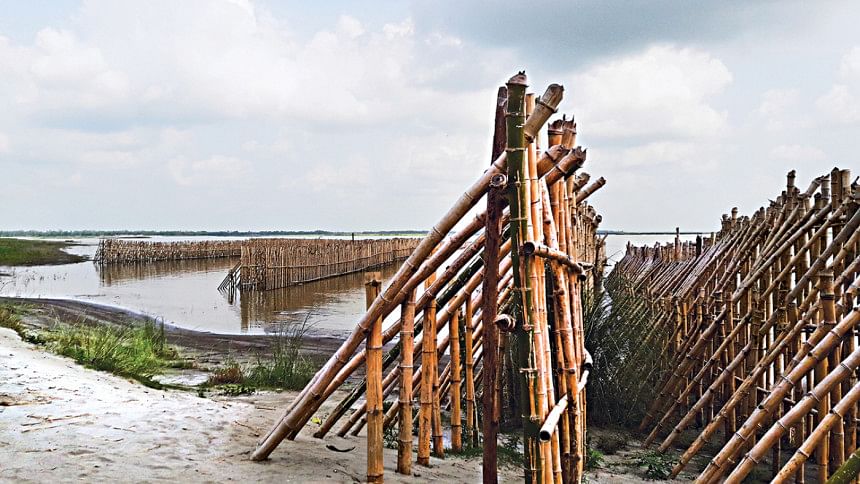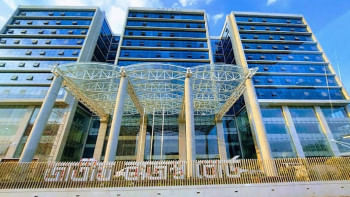An indigenous way to save our soil

Namapara village is like any of the 84,000 villages of Bangladesh. Located in Rowmari upazila of Kurigram, the poorest district in Bangladesh, this village is inhabited by some 200-250 families, most of whom are impoverished farmers. The Jinjirum, a meandering river originating in the hills just across the border, shapes the fate of the villagers—sometimes by providing them with a bounty of fish and alluvial silt and sometimes by inundating the village and destroying their harvests. However, inhabitants of this ordinary, impoverished village have devised a way to reduce its vulnerability to natural hazards such as flash floods and river erosion, which has created quite a stir among the neighbouring localities. Actually, they have reintroduced a native technology of river training which had been forgotten due to long periods of disuse. This technology is known as 'bundaling' among the people who live along the Brahmaputra river system.
A 'bundal' is a complex, multilayered bamboo palisade that can protect the riverbank from flash floods, in the process increasing navigability of the river. Depending on the width and strength of the river, several bamboo posts, each 25 feet long, are installed vertically into the riverbed where its bank is vulnerable to erosion. Each post is installed 13 feet deep into the riverbed. The vertical bamboo posts are supported by horizontal ones of the same length. The gaps between the vertical and horizontal bamboo posts are stuffed with wooden planks, sacks of jute, and straw to reinforce the structure. Each set of bamboo palisade is installed at an angle of 45 degrees towards the direction of the river current. Depending on the strength of the river, several layers of bamboo palisades are installed at vulnerable points of the riverbank.

Ahad Ali, a farmer and an inhabitant of Namapara village, is an expert in constructing this kind of bamboo structure. He says, "My original home is in Chilmary, on the bank of the Brahmaputra. My home and croplands have been washed away by that river. My ancestors used to construct large bundals to tame the currents of the Brahmaputra. I heard about this technique from my father and grandfather. But, due to government embankments all along the river, they could not construct large bundals that could prevent Brahmaputra's current from scouring. However, the government embankment could not save us. We lost all our belongings. Then I settled here and with the help of local villagers and the local administration, along with my neighbours, I started to construct these palisades to save our croplands."
This method is not unknown to Bangladesh's river researchers and engineers. According to Kazi Rezaul Karim, chief scientific officer at the Bangladesh River Research Institute (BRRI), "The network of bamboo palisades acts as a natural dredging machine. The bamboo palisades, installed at an angle of 45-50 degrees towards the direction of the river current, obstruct the river current and trap alluvial silt. In this way, the palisades naturally rebuild the banks and increase the amount of fertile croplands. On the other hand, the palisades divert the current to the centre of the river. As a result, the river naturally scours the riverbed instead of the banks which increases its navigability." To assess its effectiveness, BRRI has set up a series of bamboo palisades along different channels of the Jamuna and Padma rivers. "We have already got satisfactory results to some extent. We set up palisades along the course of the Gorai river. We have experienced effectiveness of the palisades this monsoon. Most parts of the banks are still intact and we are expecting that the river's navigability will also increase in the next dry season. Since it's a natural process, we shall have to wait a couple of years more to fully understand its efficacy."
Eminent river researcher and bundaling expert Sheikh Rokon, secretary general of Riverine People, thinks that efficacy of this technology has already been established in our history. He says, "In the past, agriculture, transportation and trade of this part of Bengal depended mostly on the rivers. We had to ensure that these rivers supply us with enough silt to make our croplands fertile and, at the same time, remain navigable throughout the year. And, to do so, our ancestors constructed bundals of different sizes all along the rivers."
"Most of our rivers change their course so frequently that it is sometimes impossible to tame these rivers artificially by building concrete structures. However, our engineers are still reluctant to use bundals because many of them are unaware of the resilience of this structure and the modern dredging and embankment techniques require large amounts of funds which allow for corruption," he adds.
Due to a lack of awareness about this method, these bamboo palisades are being constructed defectively. In Rowmari upazila, several palisades were seen constructed parallel to the bank that is at a 90 degree angle to the current of the river, instead of at 45 degrees. As a result, local people cannot access the riverbank and during the current monsoon, several of these palisades have already been washed away. Again, villagers have to install only a single layer of palisade due to lack of funds and material and for the same reason, they cannot maintain these structures, which reduce their efficiency.
"Bundals have to be repaired frequently. Jute boards and wooden planks need to be changed regularly. Regular siltation buries the bamboo posts. In such cases, the structure needs to be shifted towards the vulnerable bank. Also, we must ensure that bamboo posts are driven at least half of their length into the riverbed. For this purpose, we need heavy hammers to insert the bamboo post. Otherwise, the structure will be washed away by the river current. To ensure sustainability of the structure, we need funds and intense labour which we don't get in our village," explains Ahad as to why they cannot construct sturdy palisades. Despite these limitations, usefulness of these structures has propagated to the neighbouring villages of Namapara. Villagers of Bakbandha and Bikiribeel villages have already constructed bundals with the help of some development organisations and the local administration.
However, according to BRRI, bundaling still requires 10 times less the funds than modern dredging methods require as well as increasing navigability and helping to increase fertility of the agricultural lands. By using bundling, depth of a riverbed can be increased up to eight to 10 feet homogenously and sustainably whereas the modern dredging method sometimes damages the riverbed, by hampering the natural flow of the river and thus accelerating river erosion.
Every year, Bangladesh's economy gets badly affected due to river erosion. According to the Bangladesh Water Development Board, more than two and half crore people of 43 districts have lost their homes due to river erosion in the last 10 years. In the last four decades, Bangladesh has lost more than 100,000 hectares of land due to river erosion, an area larger than many of the districts of Bangladesh. The government also spends a large amount of resources to protect the riverbanks. For instance, the government took up 76 development projects in the water development sector for the fiscal year of 2018-2019. 30 of these development projects are to protect the riverbanks and to dredge the riverbeds. These projects have consumed no less than Tk 21,000 crore.
However, mounting loss of land and resources prove that these conventional, fuel intensive methods are failing and it is high time for the government to think about alternative methods to reduce river erosion. And bundaling, a natural and 'green' way to protect the riverbank and dredge rivers, deserves serious consideration.
The writer can be contacted at [email protected]

 For all latest news, follow The Daily Star's Google News channel.
For all latest news, follow The Daily Star's Google News channel. 



Comments